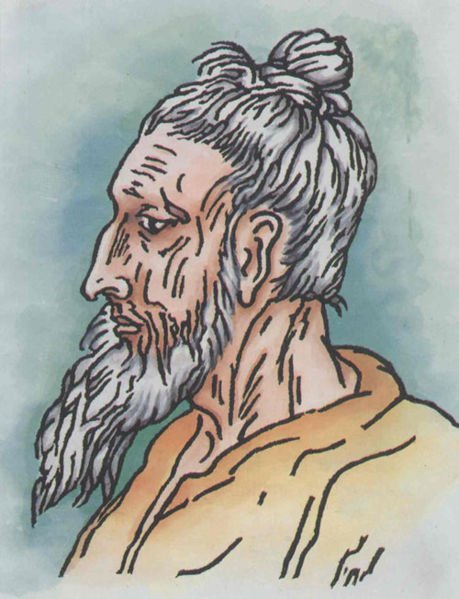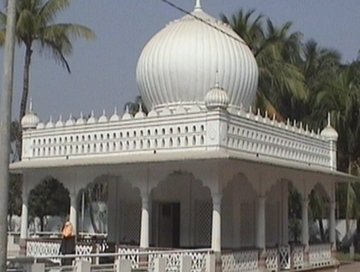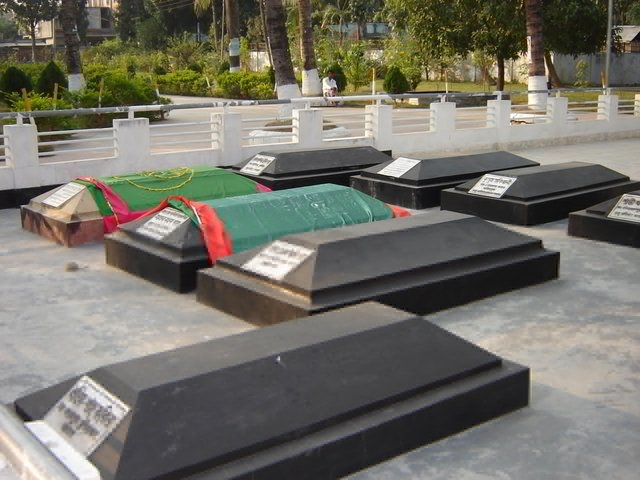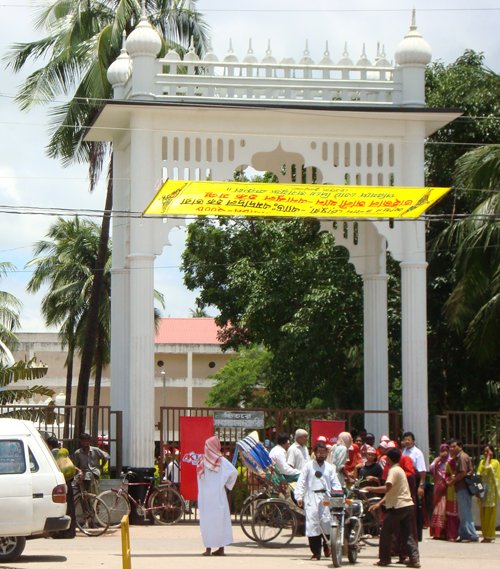A short biography of Lalon Shai
Sufi Legend Lalan Shai, brought by Goraiin a time long gone.
World’s greatest spiritual dervish,
Put to sleep on the banks of the river Kaligang,
While his thousand ektaras wake up Bangladesh.

Lalon ShaiWhom did the flowing Gorai bring? Who is termed as the world’s greatest spiritual dervish? Who sleeps by the bank of the river Kaligang? Bangladesh wakes up in the tune of whose ektara (one stringed instrument)?
The answer to the four questions above is the same. He is like of ‘sovereign’ ruler of baul music – Lalan Shai, also known as Fakir LalanSai, and to his thousand followers, simple Saiji.
About 235 years ago, in the year 1774, LalanSai was born in the Bharara village, of Chapra Union in the Kumarkhali Upazila of Kushtia. Back then, Kushtia was not a division, rather a Mahakuma within Nuddea district of undivided India. Kumarkhali was a mere union.
He was born in an illustrious, pious Hindu family at Bharara beside the flowing Gorai. He lost his father Sri MadhabKar at an early age and was reared with love and tender affection by his mother – Srimati Padmabati. Due to the early demise of his father, Lalan had to face the burden of running a family from a tender age. In the struggle of life, he only had his mother by the side. To ease the suffering of Srimati Padmabati, Lalan got married. He was a righteous and pious man but as he was misunderstood within the family circle, he went off to live at the nearby Dashpara village with his mother and wife.
He received little formal education; the struggle of life took that away from him. But from a very early age he was interested in music. Lalan was the centre of attraction at all musical soirees in Bharara, be it kabigaan, palagaan or kirtan. People were mesmerised by his magical voice.
At a young age, Lalan decided to accompany Bauldash – his neighbour at Dashpara – and other acquaintances to a pilgrimage to Baharampur of Murshidabad for a dip in the holy Ganges. Communication in those days was arduous and Lalan and his group set on foot. Only the very rich and respectable in society could afford a bullock-cart or a horse drawn carriage at that time.

Lalon Shaiji's Mazar
Lalon Shaiji’s Mazar
On his return journey from the pilgrimage, Lalangot infected with small pox. His condition deteriorated and at one point,Lalan became unconscious. His friends, thinking he is dead, put fire on his mouth — as was the Hindu ritual -– and set him afloat on the river.
His poor family was shocked by the news of Lalan’s death. They were left at the hands of fate with their sole bread earned now floating on water. It is important, as we will later see that Lalan’s last rites were executed according to the Hindu scriptures and their rituals.
By a twist of fate, Lalan’s floating body reached a bank where a woman found him, while fetching water. She saw his land’s tremble, his eyelids blink. The woman, a Muslim from the Karikar family, took Lalan and offered him care and shelter.
With proper nursing and attention, Lalan soon regained health. Pox, however, took its toll and he was left with hideous scars on his face and left blind in one eye. He now wanted to return to his village and his familiar crowd.
Srimati Padmabati’s joy found no bounds seeing Lalan alive and back. His pious wife could not thank the Lord enough for his mercy. This however was not long lasting.
Lalan back from death — this was news throughout the land and people started to come see him in large numbers. Along with the commoner came the social lords who made it clear that he could not return – his funeral has already taken place according to Hindu rituals and he had also received water from the hands of a Muslim. Lalan had to leave.

Mazar of Lalon Shaiji's Followers and Other Fakirs
Mazar of Lalon Shaiji’s Followers and Other Fakirs
Lalanwas prevented from returning to normal life as ‘religion’ did not seem it fit; the very same religion for which he had set on a pilgrimage in the first place. Lalan left all that he knew – his motherland, his friends and above all, his family. His wife expressed the will to accompany him but religious restrictions and fear of being declared an outcast prevented her from going with Lalan. She never did recover from the shock and soon passed away.
This event had a profound effect on the later teachings of Lalan and in reality this was the beginning of the thoughts that later gave him universal recognition.
Secluded fromsociety, Lalan thenmet SirajSai, a spiritual man of the Kahar community. Under his influence, Lalan rose to prominence as a guide to spiritual thought. Accepting SirajSai as his guru, Lalan became – LalanSai. The relationship between Siraj – the mentor, and Lalan – the apprentice, was deep. He was a firm believer of his Guru and later wrote –
Guru, you are the tune of the tantra
Guru, you’re the counsel to the mantra
Guru, you’re the sound of the instrument
Without you, how will it play?
Lalan firmly believed that Guru is a reflection of the Supreme power. To him, respect to one’s guru was homage to God. It was by the direction of SirajSai that Lalan made his domicile and ‘akhra’ (shrine) in the Cheuriya village of KumarkhaiUpazila of Kushtia.
In his initial days, Lalan used to meditate under a mango tree in the forests of Cheuriya. He never came out of the forest and used to live on ‘anmel’ – a type of taro (kochu). Soon the word spread of this mystic in the forest, who meditates all day.
Cheuriya was the base of the Karikar community and these same people stood beside him. With his permission, the Karikar’s made a refuge for Lalan and his disciples and accepted his apprenticeship.
Soon his fame spread in the neighbouring areas. Initially Lalan spent little time at the akhra and would travel in neighbouring Pabna, RajShaii, Jessore and Faridpur teaching the gospels of thought where man prevailed among all. This is when his music reached far. Irrespective of their religious beliefs, both Hindus and Muslims became his shishya (disciple). Because in Lalan’s words they found direction for emancipation; Lalan spoke of a world free from religion and caste, which appealed to the common man.
Amidst this radical change in his life as a sage, Lalan thought of his mother in every step. He had embraced the love for his mother and nurtured it throughout his spiritual existence. He mother too, cherished the memories of her dear son. When the news of her death reached Lalan, he sent every essential necessary for a funeral; food and other provisions. After Lalan was made a social outcast, his mother took refuge in the akhra of BairagiKumbhaMitra and spent the last days of her life there.
Lalan was rejected by society because of the caste system, and Lalan declared a war against it. He wrote:
Without losing caste I find no God
Why then do you pride caste
You untouchable.
Lalan says – if I had it in my hands
I would put it in flame.
In those times, superstition and religious fundamentalism had put darkness on people’s thought. At that time Lalan walked miles to preach his ideology against all darkness in society. He and his disciples, as expected, faced persecution because of the threat to social norms their teachings possessed.
Both feudal lords – Muslin and Hindu irrespective – took an opposing position to his words. They would shave bauls, break their instruments wherever they were found. But the bauls find not give up spreading the message. The persecution reached a pinnacle after the death of Lalan, and further still after the demise of BaulShital Shai and Bholai Shai.

Lalon Complex Gate
Lalon Complex Gate
The 16 bigha land donated by his follower Bhakta Shai for the shrine of Lalan, went up for auction on 11 December, 1945. Luckily, a man by the name of Ismail Shai bought the land for 100 rupees and 4 annas and preserved the place as Lalan’sakhra. Throughout history, his spiritual followers have helped in the preservation of Lalan’s legacy.
People have had debates as to which religion Lalan belonged. Muslims have claimed him to be one of their own, as did Hindus. After the feudal lords declared him a social outcast, Lalan shied away from formal religions. Scholars believe that up on the influence of SirajSai, Lalan may have accepted Islam. But in his music, people find a self-declaration on his religious views. He wrote –
All men say Lalan what’s your caste
Lalanreplies, never did see the image it casts.
He has made his position ever clearer through the instructions left for his last rites. Upon his demise, there was to be no last rites – Muslim or Hindu. He was clear that he neither wanted a Janaza (Muslim prayer over the dead) or a HariKirtan at the burning pile (Hindu ritual). He was buried in the very room he lived in. Lalan wanted a celebration of the Baul concept around his grave, as we see today.
This indicates that Lalan was not a follower of any formal religion but he maintained good relations with people adhering to all religious thoughts. People in general felt that Lalan was their own and it is probably thus, people of all religions have claimed him as their own.
In reality Lalan believed in the worship of the mentor, Gurubad, as it is called. His followers believed that adoration of one’s Guru is the best form of worship. Their words were full of praise for the Sai and they devoted a life towards spreading his words.
Inside Lalon Academy Auditorium
Lalan had taught people to fight the evils of religious intolerance, the caste system, superstition and fundamentalism and to uphold their conscience. Lalan urged people to treat each other equally by killing the beast within. Although unlettered, in the school of consciousness he has left a trove of teachings for the scholars in the entire universe to research and ponder on. His astute teachings have made a profound addition to humanity’s understanding of knowledge and is being utilised for raising social awareness even today.
Lalan used to reply through music whenever his followers asked him questions or enquired about matters. His impromptu replies through music would deeply touch people’s heart. Whenever he felt inspired, he would call upon his disciples saying “School of fish fries” and his students would come with the dotaraand the dugdugi. PanditManik Shai and Moniuruddin Shai were his long standing scribes and would write whatever Lalan said.
Followers of Lalan claim that he had composed over 10, 000 songs but scholars believe that the number is closed to 1000. From the mouth of the fans of Lalan, his songs have reached the common people. His work is now spread throughout Bengal.
Congratulations @aliamjad7000! You have completed some achievement on Steemit and have been rewarded with new badge(s) :
Click on any badge to view your own Board of Honor on SteemitBoard.
To support your work, I also upvoted your post!
For more information about SteemitBoard, click here
If you no longer want to receive notifications, reply to this comment with the word
STOP